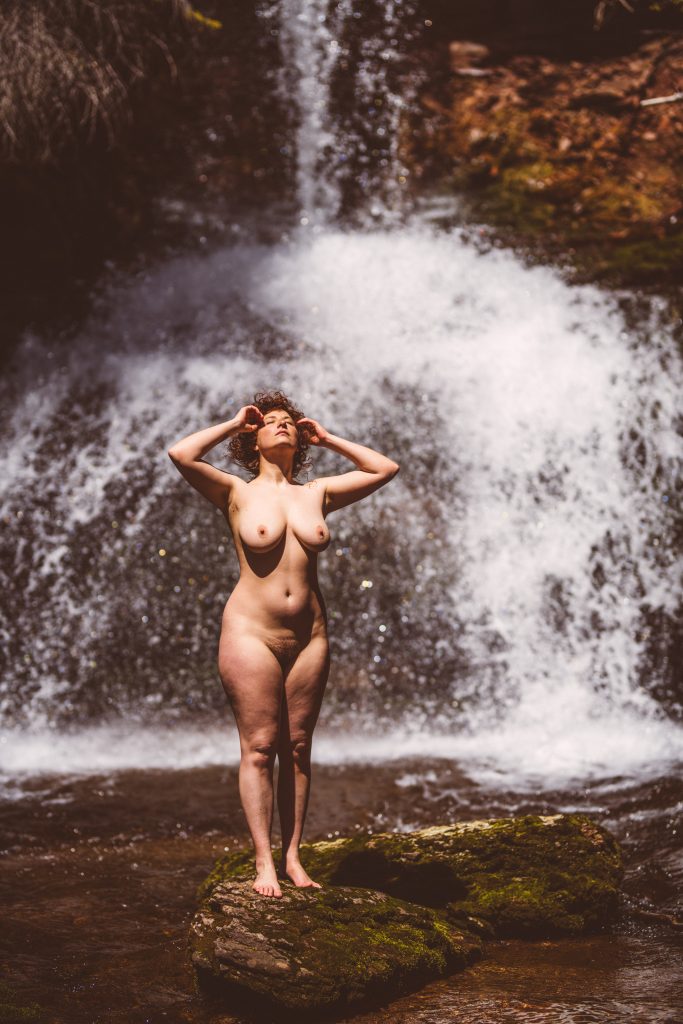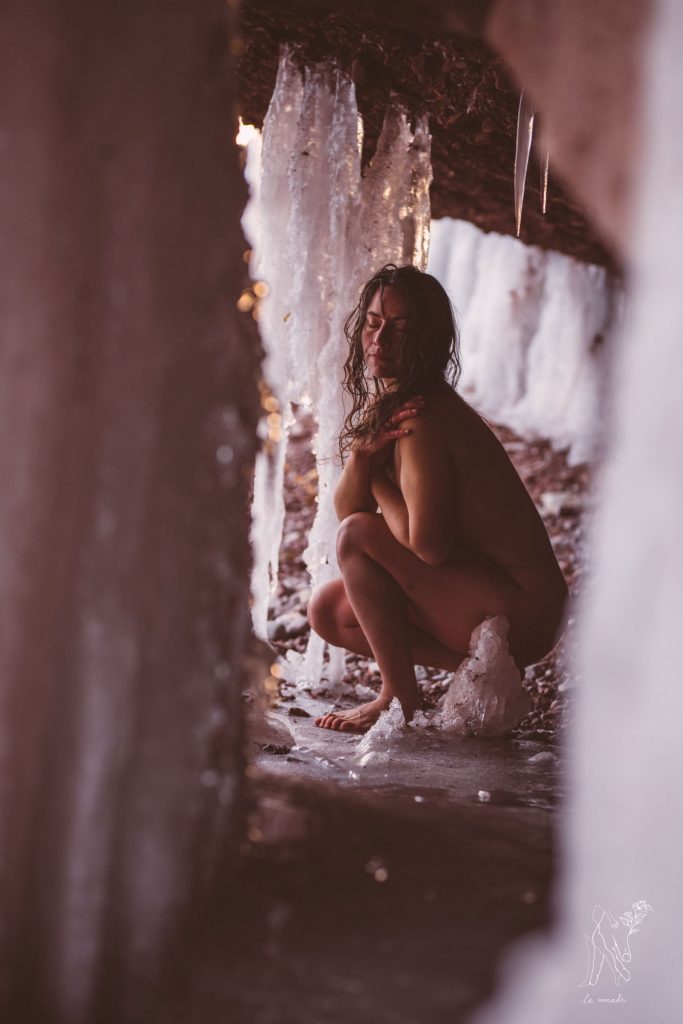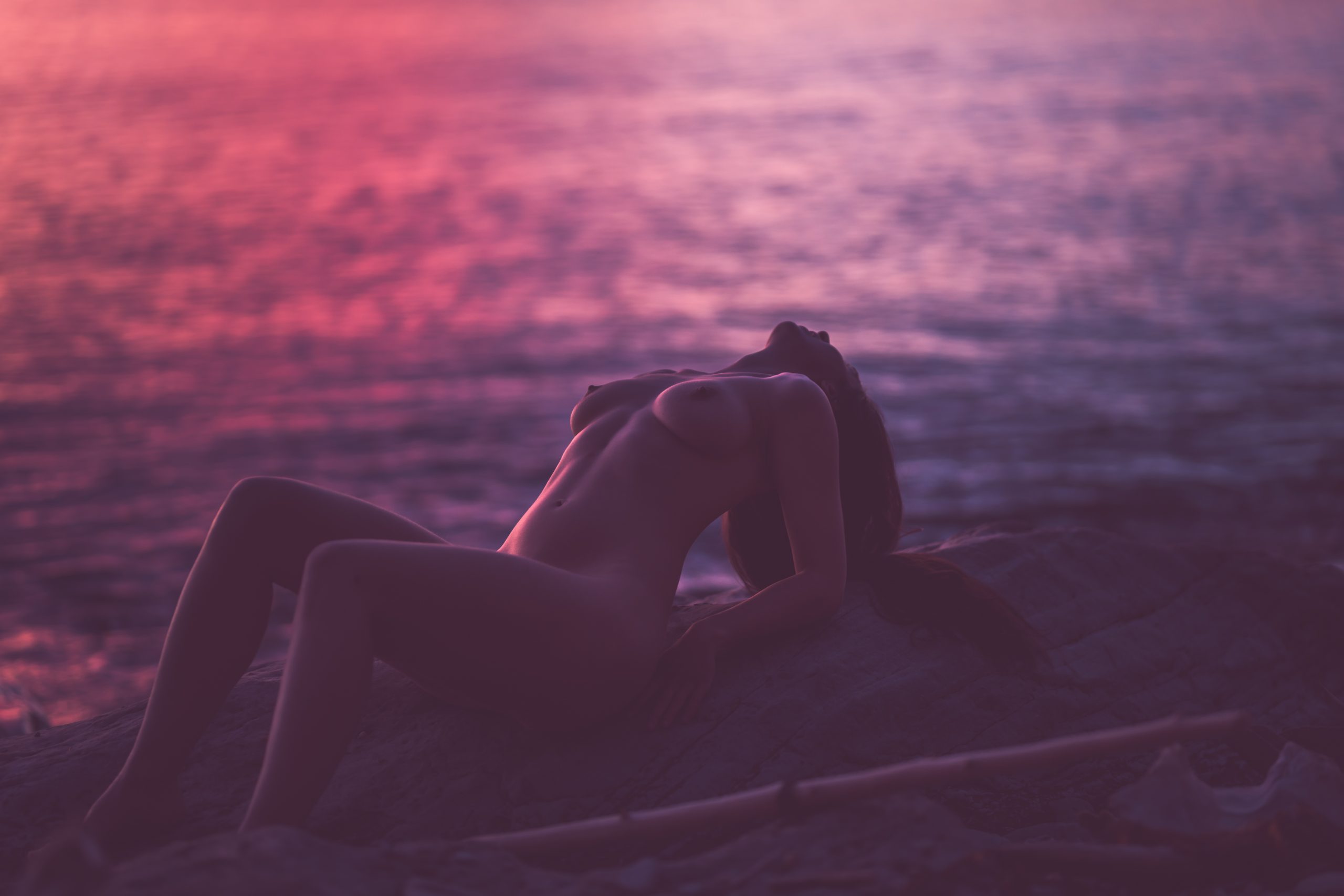Territory-Art: a Gaspésien coffee with La Nomade Photographie
[ ART-TERRITOIRE: un Café Gaspésien avec la La Nomade Photographie ]
In the province of Québec, Canada, the Loi 101 states that all commerce and commercial products’ names have to be written in French before they are in English. This law is to protect and conserve the French language in a territory that is surrounded by English dialects. It is therefore worth mentioning that the exchange which led to the following piece of writing was solemnly in Québécois, or Canadian-French, and is therefore entirely translated. It does try to recapture the, albeit sometimes untranslatable, slangs and phrases that were uttered in the midst of the encounter.

I was greeted by the sun, her Australian Shepherd (who ran around with my Border Collie like crazy), and a coffee in her backyard (right next to where her partner was at work in their large fruits and vegetables garden). Typical from Québec, from my home territory, I was greeted by Johanna Moya, La Nomade Photographie, as a friend, as someone who was welcomed in her home. We chatted for almost two hours, discussed and philosophised about the concepts of home, territory, body, ecofeminism, censorship, art, humans and nature. We laughed and understood each other for the brief moment of our encounter. I left with one of her beautiful photographs (printed on ecological paper), my head full of titillating topics to explore and a bag of sweet snaps issued from their land.
I am now sitting outside my tent, surrounded by pine trees and mountains, thinking about how to write down Johanna’s vision, inspiration and relationship with both the naked woman’s body and with nature. My dad just made me my favorite coffee, my brother is feeding me pieces of peaches, my mom is humming songs, my dog is sleeping at my feet and mosquitoes are buzzing around my ears; surrounded by my family’s and nature’s morning turmoil, I came to the conclusion that this is a piece about the essentials. A piece about searching and finding and being home.
Johanna is a professional multi-disciplinary artist who started her self-taught career in photography, after her dad offered her a camera, at the age of twenty-four. She was born in Marseille, France, and stepped over many territories such as Australia and Spain, before establishing camp in Gaspésie, Québec, Canada. She found a part of her moving identity through her different encounters with different environments, through her nomadism. She found her identity in movement.
“We don’t know who we are, but we know how many kilometers Pluto is from the Earth!”
Johanna’s search for identity found a particular place for growth, a territory to root itself in, in the region of Gaspésie. Filled with emptiness and space and vastness, the opportunity arose for Johanna to make art that resembled the territory and herself. Her projects found themselves working with and for nature. They flourished without social pressure and found their voice by rejecting society’s mandatory artifices. Without add-ons, appendages, attachments, accessories, “sans flas-flas” as we say in Québec, Johanna could finally question her personal priorities rather than those of the artistic industry. The priorities that presented themselves as being the most prevalent in her art are: the constant search for one’s true identity, the courage of being vulnerable, the abolition of taboos and stereotypes about the naked female body, as well as the cohabitation between humans and nature.
When she established her home in the Gaspésian territory, far away from the aggressive and noisy metropolitan center where appearance is more important than being and where the conventions, the censorship and the pressure to continually create can make one feel outside of themselves, Johanna felt that she could finally develop her individuality and her art in a direction that was fully and completely hers. She was offered the mental space to ask herself: what’s left? Who am I and what do I really want? Once I am stripped naked in the immensity, in the chaos, in nature’s different type of noisiness, what’s left?

“Some of the women I worked with took months before they finally contacted me after making the decision to book a session with me. Returning to ourselves can be a process that hurts, but the encounters and the moments of vulnerability that we experience during our meetings can work as a starter in regard to introspection and in regards to starting this search for the true and authentic self.”
The living images captured by Johanna’s photography are suspended moments of self-expression, authenticity and even rebellion. Fixed in a world that is constantly moving, the landscapes born from the collaboration between Johanna, the specific model and nature make for a strong, exclusive and loud (political) statement: I’m alive, I feel, I’m allowed and I am beautiful. Johanna’s focus isn’t on creating a perfect image. She is against this perfection-fiction that takes away our uniqueness, takes away what is so ferociously ours, what makes each and every body rich, imperfect and stunning. The focus, then, is on being. It seems so simple: just be. But simply being, in today’s day and age, demands vulnerability. Being vulnerable demands authenticity. Revealing oneself without censorship demands courage. A lot of it.
“Vulnerability is a double gift. It can be an actual gift of the self which carries the possibility to create or strengthen links between individuals. It can also be a liberation, an opportunity to explore oneself in order to own oneself better. Vulnerability is the courage to face, accept and love our emotions. The courage to be true to oneself. Vulnerability is the privilege of seeing.”

In my brief meeting with Johanna, she never spoke of her sessions as photoshoots, but as encounters. The connection that she makes with her models is, more often than not, a strong and lasting one. She creates cocoons of vulnerability where the women she meets are offered a space to show themselves naked, raw, true, fearless and vulnerable. For herself, as well as for her models, Johanna seeks self-discovery, self-rediscovery and a sense of belonging to oneself and to one’s environment. The search is one for a safe and comfortable “home” that makes for the possibility to cultivate self-love.
“Gaspésie is often described as the end of the world, but for me it represents a start. The start of my reconstruction in nature, the start of my search for identity.”
For Johanna, her new homeland, or “terre d’accueil” was a home where she found the possibility to have a dialogue. A dialogue with herself, a dialogue with humans, a dialogue with culture and a dialogue with the territory. The land that has been taken to establish the province of Québec has a dense, and for some painful, history. Reconnecting with it can be as much of a hurtful process as reconnecting with one’s vulnerability. That being said, by rejoining with this nature that has been abused and disregarded as much as the woman’s body has been through time and age, it might be possible to construct a territory (both environmental as well as mental) that is in harmony with its history. A territory is not a fixed entity but is in constant movement. Our vision of both ourselves and our environments therefore has to follow the waves, curves and unexpected windstorms that are intrinsic to them both.


Ecofeminism is a philosophical and political movement creating an ecosystem where feminism and ecologism are merged into one where the aim is to revisit one’s body and surroundings. Self-rediscovery through and with a certain territory, as well as exploring a territory through women’s bodies, makes for a mutual revalorisation and the start of a healing process for both nature and the self. Combining the naked, raw woman bodies with the naked, raw spaces, Johanna’s images enter the movement of ecofeminism. Johanna celebrates, captures and immortalizes the healing connection between a mental and an environmental territory. Through her images she says: Look, this is how it is and it’s not any other way. None of Johanna’s shots are reworked with Photoshop, as she believes that a naked body is just as beautiful the way it is as nature. Nature doesn’t need to hide itself behind fake appearance, why should we?
Johanna, in line with the ecofeminist movement, sees the woman’s body as a territory to be explored. She made sure to state that sexual organs have nothing to do with being a woman. Being a woman is being strong and raw and brave and vulnerable enough to authentically show your mental home to yourself and others. The female body is a galactic one. After centuries of being (over-)sexualized, fictionalized and made into a taboo, it’s time to present the woman’s body as it is, without hiding behind unattainable artifices. We have to break with the stereotypes that have forced women into a mould that “has the form of other people’s desires”. This mould that is offered, and maybe even forced upon women, has to be re-explored and reconstructed through asking ourselves if the mould really fits. We have to recreate roots, rebuild our home-bodies to something that we want to live in. Rather than accepting the unnatural-self we have been said to be, we have to rejoice with our animal, savage and imperfect side, our natural and true selves.
Nudity is a big part of Johanna’s images for exactly this reason. Our bare bodies are as much a part of nature as mountains.
“We can do everything naked. We can climb, hunt, pick fruits, smell, feel. Nudity is at the basis of everything. Being naked is going back to the essential, to the natural.”
Johanna mentioned that our bodies “fit” with the environment. When we put a seashell to our ear, she says, the sound of the sea that we hear is soft and perfectly adapted to our ear. We have the capacity to recognize a tree by the way it feels on our skin, even with our eyes closed. We know which food is good or bad for us depending on its smell. We are made to coexist with nature and to experience it in a sensuous way. We all take part in the same ecosystem, without one entity overpowering another. It’s a strength to be conscious of our space and smallness in the bigger ecosystem. Working and creating with nature is uncomfortable, chaotic, unpredictable and humbling. It strengthens respect for the environment, for our bodies that evolve within it and for life itself. Life is about chaos, but life is also about “tenacity, clairvoyance and strength”. Life is about figuring out what our essentials are. About finding out where and what our homes look like.

Finishing this piece of writing, I am thinking about my own homes. My own territories. My body and my environments are two spaces that I can make safe and comfortable. Johanna chose to become the wave that makes change in her own life. She chose to be safe and happy. She chose to establish her home-body in a home-environment that resembles who she truly and authentically is. I then take home from our encounter that, by knowing what I need, what I want and who I am, through being vulnerable and through being in sync with my personal ecosystem, I can be happy. Right now, this happiness is to leave my computer behind on the picnic table, and to go spend some quality time with my family. Is to laugh with them, sing together to some old–school rhythm and blues. It’s to breathe in the fresh sea air that is so typical from Gaspésie, to try to find the Orion Belt in the starry night (the only constellation I know and one my brother just told me is impossible to see in the Québec sky during summertime…) and to sip my beloved Québec cider. Right now, my happiness is to absorb my environmental territory so I can carry it to Europe and feel it in my body when I go to sleep in a bed that’s about 6000 km away from here.
Johanna Moya, La Nomade Photographie, is currently working on a new ecofeminist and collaborative project combining visual and textual artistic pieces and is looking for people that are interested in participating in this project. Don’t hesitate to get in contact with her through her website: https://www.lanomadephotographie.com/